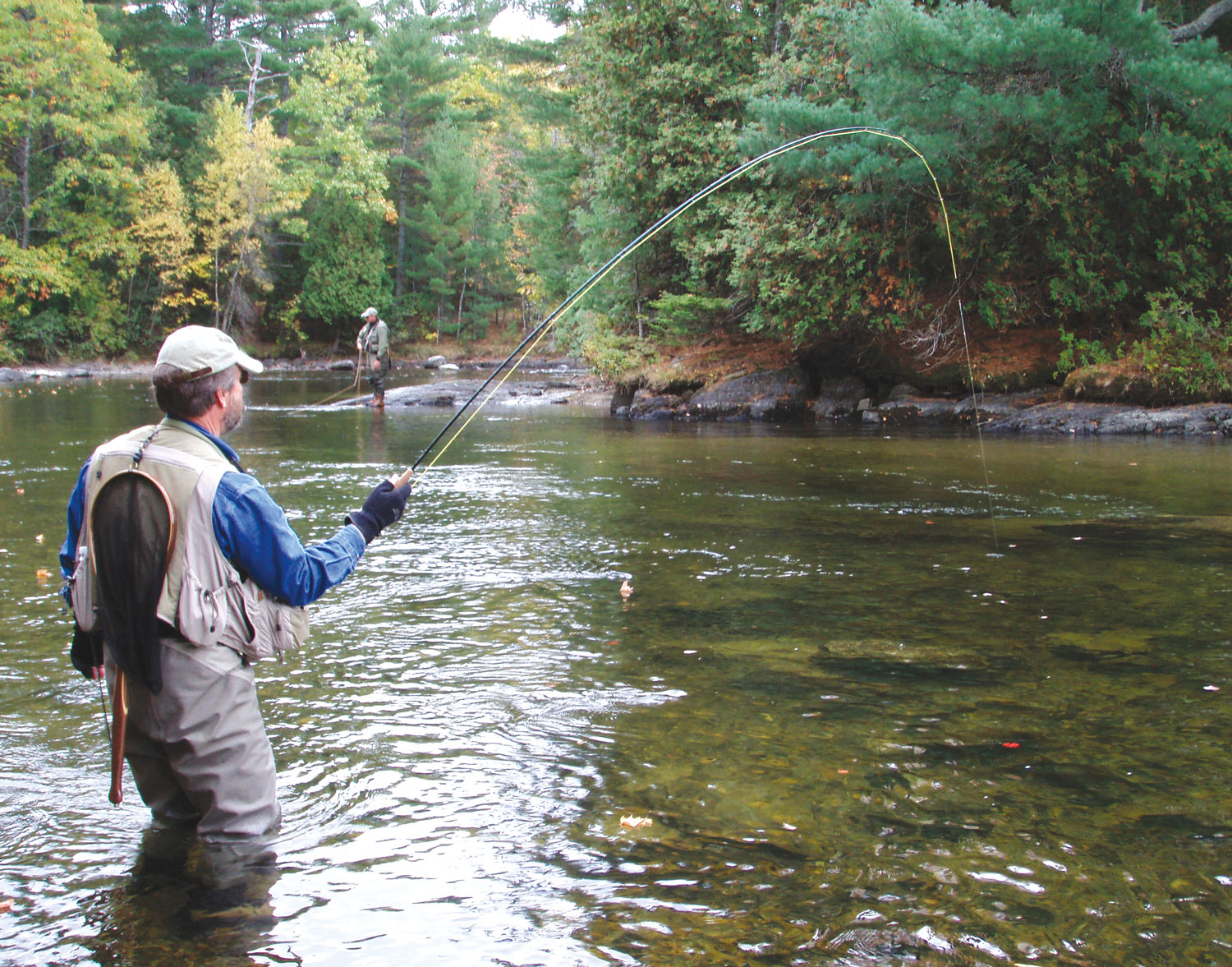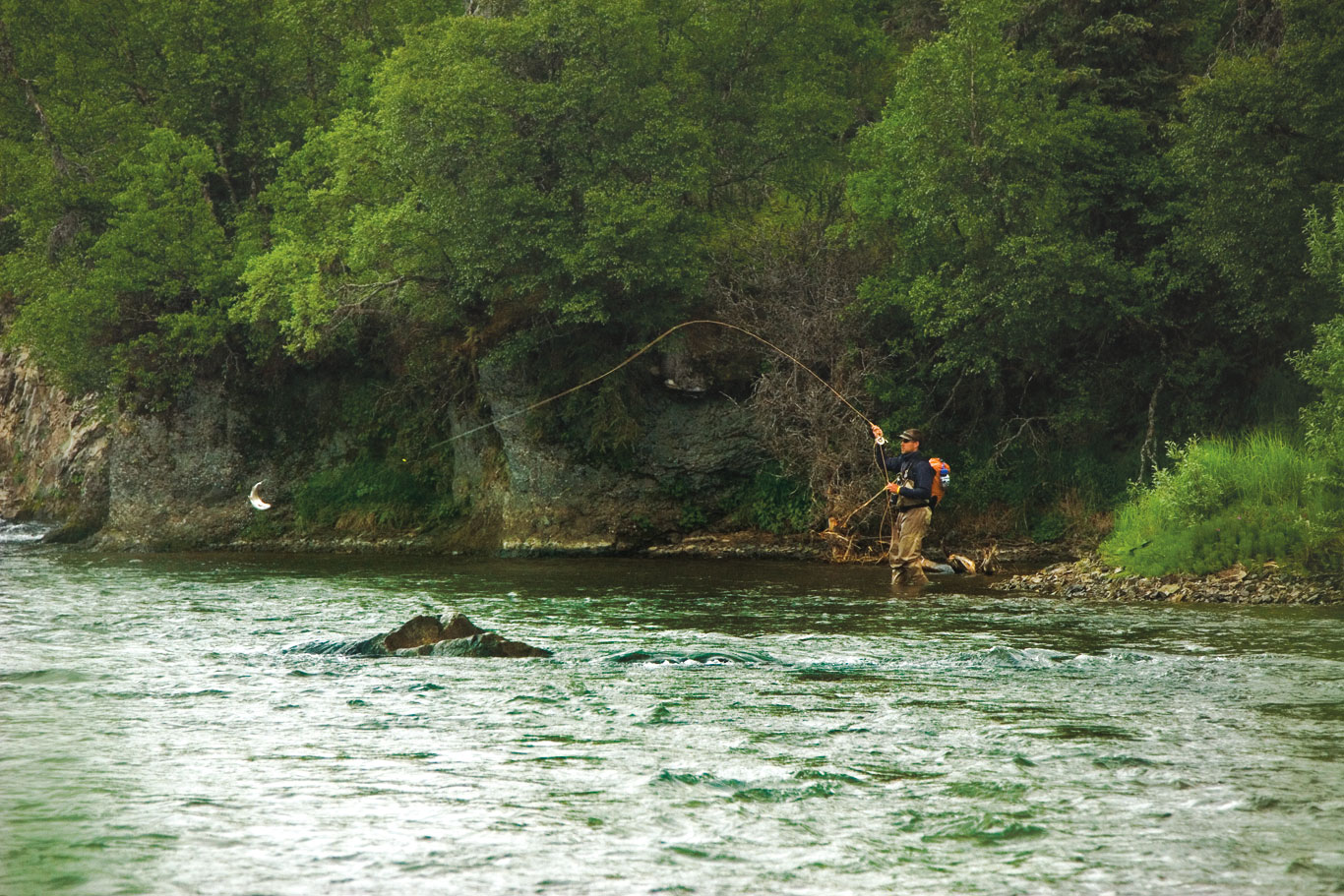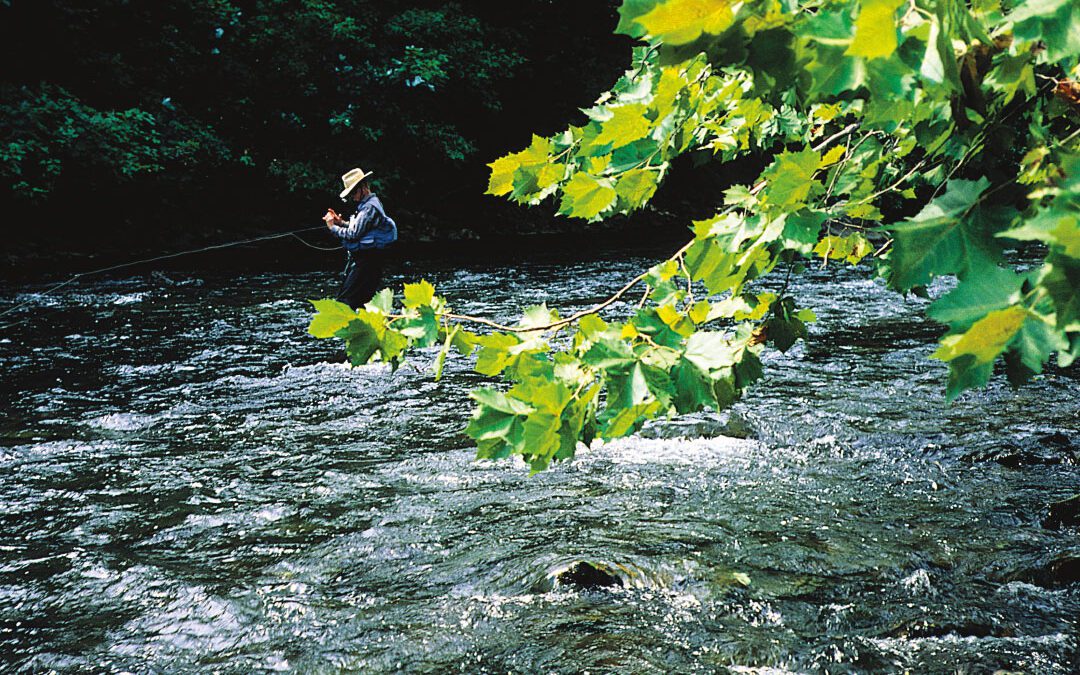NORTHEAST
Grand Lake Stream. Grand Lake Stream is that happy 3.5-mile stretch that drains Maine’s West Grand Lake into Big Lake. You’ll find big runs of landlocked salmon, stocky native brook trout, and below the Big Falls, smallmouth bass. Fish Curt Gowdy’s pool just after ice-out when leaves have yet to green. Or tickle brook trout with your three-weight beneath the forest’s riotous fall hue. From April ’til October, you’ll be charmed on this jewel of a trout and salmon river.
Upper Connecticut. There’s no finer place in the East to cast flies or hardware, whatever your preference, than the upper reaches of this river just south of the Quebec border between New Hampshire and Vermont. The 2.5-mile run between First Connecticut Lake and Lake Francis is famed for landlocked salmon spring and fall, and the 30 miles below Lake Francis is marvelous brown, brook and rainbow water. Give yourself six days and come in early October, so you can hunt grouse and woodcock.
Beaver Kill. You cannot escape the feeling of fishing in a museum when on the Beaver Kill. From the confluence of the Willowemoc five miles downstream to Cooks Falls, the river’s runs carry names like The Forks (Junction Pool), Ferdon’s Eddy, and Barnhart Pool. This is big water. Plenty of room to cast and to think about others who’ve fished here since the mid-1800s. While you’re in the Catskills, reserve a day for the joyous small browns in the upper end of the Willowemoc and plan as well a couple of days on the West Branch of the Delaware and its main stem with its steelhead-like rainbows.
MID-ATLANTIC
Little Juniata. The Little Juniata may be Pennsylvania’s best wild brown trout river. Pennsylvania Fish and Boat Commission biologists estimate that the Little J carries 2.9 wild browns per mile. An average Little J brown will measure 12 inches, and the chances of hooking one in the 13- to 15-inch range are excellent.
Penns Creek. Keystone classics Penns Creek and Fishing Creek are alike in many ways. Both are spring-fed, freestone streams. Access is excellent. There the similarity ends. One word sums up the difference. Penns is simply bigger, offering about 30 miles of excellent fly fishing, some say the best in the state, while Fishing Creek has five miles deemed great. If you throw a #16 mayfly pattern on Fishing Creek, you’ll use a #12 on Penns Creek. In short: bigger river, bigger bugs, bigger fish.

Photograph by Mike Muelle/Weatherby’s Lodge.
Big Gunpowder Falls River. When you park at the lot where Falls Road crosses the river and follow the trail upstream toward Pretty Boy dam, you could swear you’re down in the Great Smokies. Laurel blooms in May just about the time when the sulphurs are hatching. Hard to believe that this brown trout wilderness is little more than 30 miles up I-83 from Baltimore, fewer than 70 miles from Washington, DC, and just over 100 from Philly. Big Gunpowder Falls is the closest trophy trout stream to more than 16 million Americans.
SOUTHEAST
South Holston. Just into northeastern Tennessee flows perhaps the region’s finest tailwater. When the generators are off, you’ll see scads of wild browns and ’bows not ten feet off the tip of your rod. That’s when fine tippets – down to 9X – become the rule. When the water’s high, trout rise steadily to sulphurs, the river’s premier hatch. Drift floating is de rigueur. Hardy souls throw mouse and hatchling patterns under bridges at night for browns, some in the 20-pound range.
From the outflow of the Corp of Engineers Wolf Creek Dam to the Tennessee line, the Cumberland River offers some of the greatest tailwater fishing in the Southeast. This stretch produced the 21-pound Kentucky record brown trout.
When the dam’s generators are not running, shoals and other islands provide good opportunities for wading anglers. But here’s the caveat: when the generators come on, the river can rise six to eight feet! Heedless anglers can be swept to their deaths. But high flows bring forth the leviathans. To reach them you need a boat, preferably one powered by an outboard jet engine. First-timers to the Cumberland would do well to fish with a guide.
Chattahoochee. To say that the Chattahoochee suffers a split personality is an understatement. The top end of the Hooch offers about 2.5 miles of family style mountain trout fishing before reaching the funky tourist townof Helen, Georgia. When most folks think of the Hooch, though, they picture the 48-mile tailwater that flows from Buford Dam to Peach Tree Creek in downtown Atlanta. Cool through the hottest summer months, this is a miraculous trout fishery, protected by the Chattahoochee River Natural Recreation Area from one of the nation’s worst cases of urban sprawl. Take it from me, when you’re fighting a 15-inch brown, traffic noise isn’t bothersome.
MIDWEST
Bois Brule. Enthralled with line-stripping salmon, steelhead and lake-run browns with brookies up to 15 inches on the side? When the season opens in March, anglers start catching steelhead that have held over in the river since fall. In April, gleaming fresh steelies begin to migrate up from Lake Superior. That run continues into May. Chinook salmon and browns move into the river-mouth from July into October. Come August, they’re joined by cohos and fall spawning steelhead. Light-tackle anglers ply gentle headwaters in kayaks.
No one doubts that the Manastee River is justly nicknamed “The Big.” Not only does this sobriquet distinguish it from the Little Manastee, but it aptly describes this river of more than 232 miles. Cool water seeping into the river from sandy glacial soil insures that water temperatures, for the most part, are ideal for trout all year. The lower Manastee is highly regarded for runs of steelhead spring and fall when they are joined by salmon migrating up from Lake Michigan. Though waders can walk much of the river, fishing from a boat is the best way to cover this end of the Manastee. You’ll be able to hop out onto gravel bars and cast into salmon and steelhead lies that waders can’t reach. The Upper Manastee is famed for brookies.
Norfork. Here’s the challenge. With thousands of stocked rainbows and browns and brookies and cutthroats, the odds are pretty durned good that you can net a grand slam on this 4.8-mile tailwater. So let’s make it interesting. How ’bout a slam where each species has to be at least 16 inches or longer to qualify? Now that’s a Grand Slam and it’s quite possible on the Norfork. Gravel bars, submerged outcrops, occasional boulders, deep troughs and little channels characterize the river. And if you’re down here in Razorback country, check out the Little Red and the White.
NORTHERN ROCKIES
South Fork of the Snake. You’ll find superb fishing for cutthroats above Palisades Reservoir, but below its dam the tailwater becomes one of Idaho’s greatest trout streams. For the first 14 miles down to Conant, a series of braids, chutes and back channels defines the river. Below Conant, the Snake enters the section called the “Canyon,” but in reality this mileage passes a number of small 300- to 400-foot-deep canyons – Dry, Ladder, Black, Bums – before emerging at Byington launch ramp. In the canyon, the river is narrower and the water deeper. Yet numerous islands provide structure for cutthroats and rainbows up to 20 inches. For the sake of the cutts, kill and eat all the ’bows.
Silver Creek. Sliding sinuously across high prairie through the Nature Conservancy Preserve, Silver Creek is where you’ll hear only the wind in the cottonwoods and the songs of 150 species of birds. What you might also hear is: “Damn! Did you see that?” one angler exclaiming to his buddy when a 20-inch rainbow leaps out of the water. Think you can catch that fish? Maybe. Depends on how well you can manage the drift of your #22 pale morning dun. Make a mistake, and oh-so-subtle micro-currents generate wakes from fly and tippet. Big rainbows know. Real insects make no waves. These ’bows didn’t get brawny by eating phony flies.
Missouri. The 35 miles of tailwater flowing out of Holter Lake to Cascade is one of Montana’s premier rainbow rivers. Hatches are phenomenal. Baetis open the season in March and thrive into May. Pale morning duns and caddis take over in June, with the latter continuing into September. July adds tricos. Don’t forget terrestrials. If your arm is up to it, throw minnow and sculpin patterns in early spring and late fall.
Firehole. If a more exotic trout stream exists in America, I haven’t heard of it. My favorite run flows through Midway Basin. Geysers spew into the air, mudpots bubble, fumaroles steam, smelling of brimstone. Strings of bison cross downstream. In the distance a herd of elk beds down. For full effect, fish the Firehole in late September or early October. Browns and rainbows prowl these waters, but they are finicky.
SOUTHERN ROCKIES
South Platte. Perhaps the tailwater below Cheesman Reservoir is the most famous stretch of the South Platte. Close to Denver and excellent in winter, in warmer months it’s prone to be packed. Still the chance to cast for rising browns and rainbows of really good size is simply too much to pass up. The 3.5-mile Gill Trail provides easy access to the top of the canyon. Don’t overlook the headwaters, including the Dream Stream, the four-mile run from Spinney Reservoir to the top of Elevenmile Reservoir.
Arkansas. Flowing for 148 miles before bursting into the high plains and emptying into Lake Pueblo just west of the city of the same name, the Arkansas is Colorado’s most popular river for browns. All told more than 70 miles are available via 16 river access sites to anglers who walk and wade. Most of the rest can be floated, though some of the canyon sections are best run with in a drift boat or raft oared by a well-experienced guide. Anglers of deft touch often experience 40-fish days.
Provo. Before 1999, the 12-mile middle section of the Provo had been contained in a straight-jacket of levees and bulldozed channels. After a decade of restoration, a new floodplain has been established. Natural meanders, braids and side channels have been recreated. Several small parking areas have been constructed for anglers. Downstream below Deer Creek Dam, the Provo runs hard by heavily traveled U.S. 189. Considered by many to be “Blue Ribbon” water, what the Provo River Canyon lacks in ambience it more than makes up for with its 4,500 trout per mile. Trout don’t seem to mind traffic noise, why should you?
SOUTHWEST
San Juan. If it’s peace and quiet you want, you won’t find it on the four-mile San Juan tailwater immediately below Navajo Dam. From the end of May when melt-water clears the river, into October, the angler hatch is incredibly prolific. Managed as a trophy trout fishery, the chances of catching a true lunker rainbow of four to six pounds are reasonably good. On average, anglers catch one fish per hour. Such data include hapless fly fishers like me, so I’m sure that other anglers do much better.
McCloud. From McCloud Dam down the southern reach of the McCloud River Preserve owned by the Nature Conservancy, you can fish the native range of the legendary rainbows that attracted the likes of publisher William Randolph Hearst. Rods on the preserve water are limited. Private water below the preserve is held by the exclusive Bollibokka Fly Fishing Club, which offers guiding through The Fly Shop in Redding, California. The river is known for its great stonefly and salmon fly hatches. There’s an astounding hatch of October caddis and as the season enters its last few weeks before closing on November 15, leviathan browns run up the river to spawn.
NORTHWEST & ALASKA
North Fork Umpqua. On the much-storied 31-mile steelhead run of the North Umpqua, you’ll find 46 named fishing holes. Come summer, each emerald green pool tailing out in rapids that thunder and plunge into the next run will hold as many anglers as can stand each other. The allure: the summer run of steelhead beginning in May and continuing into October. Every day each pool on average will hold 150 of these beauties who love to bust up your tackle. Some days counts run as high as 500 or so. No wonder Zane Grey loved this river.

Photograph courtesy Copper River Lodge.
Copper River. Caddis, mayfly and stonefly hatches in Alaska? Rainbows on this, the smaller of the state’s two Copper Rivers, thrive on ’em before sockeye arrive bright and fresh from Bristol Bay via the Kvichak River and Lake Iliamna in July. Then, the ’bows get careless by gorging on eggs and the flesh of spawned-out salmon. The further the season goes, the fatter the fish. July and August are peak months for salmon, but that too begins to pale as the weeks slide into September when the ’bows are at their largest.
Note: This article originally appeared in the 2013 Fishing Issue of Sporting Classics.

